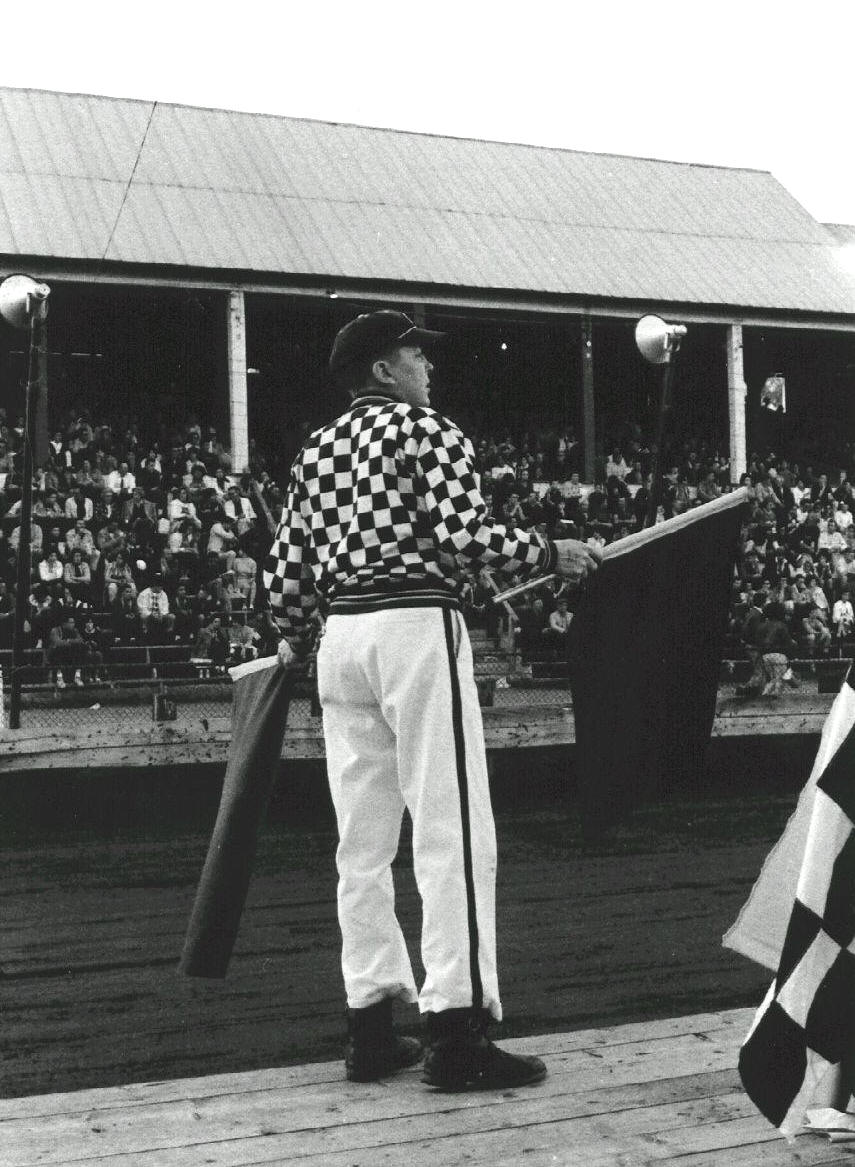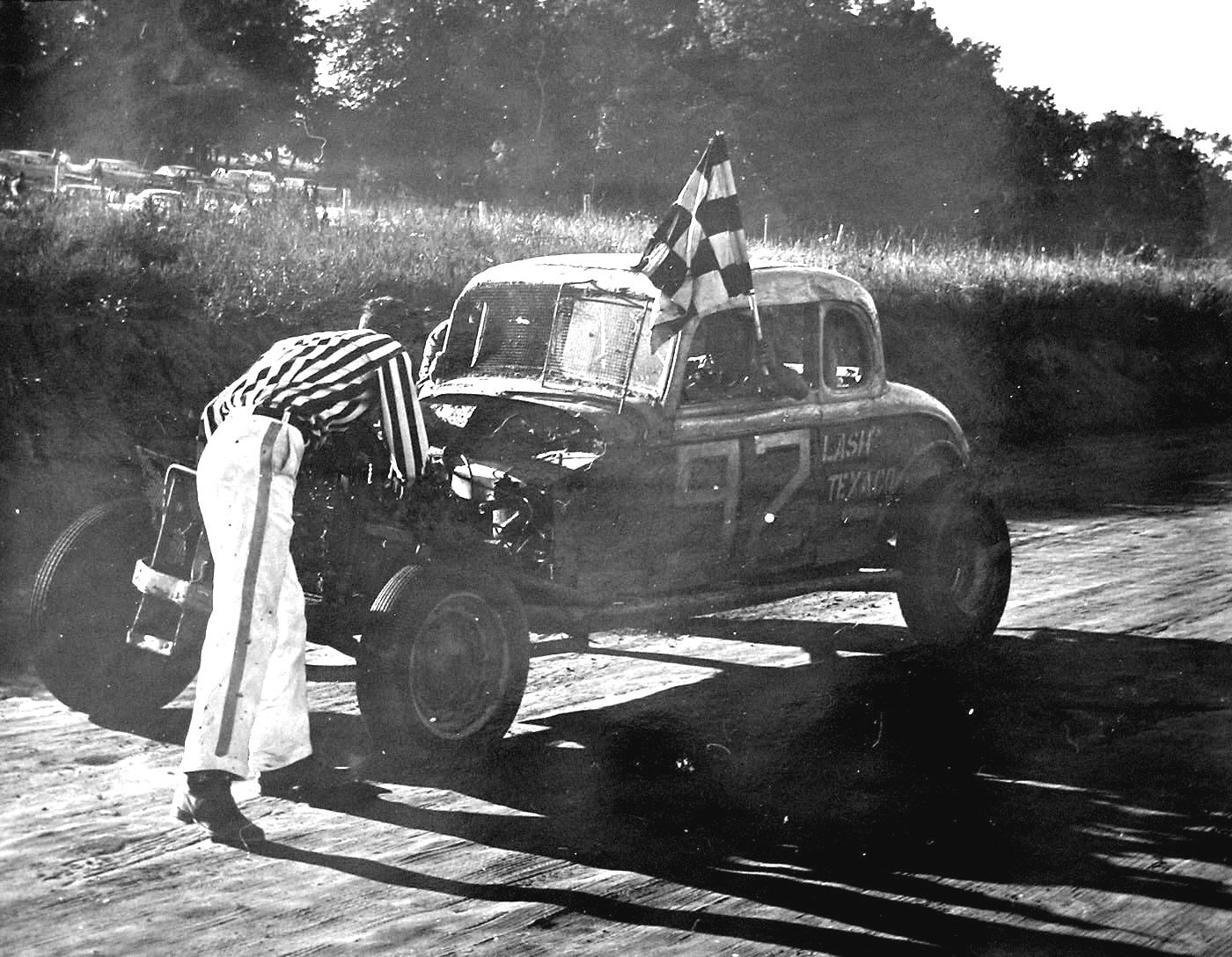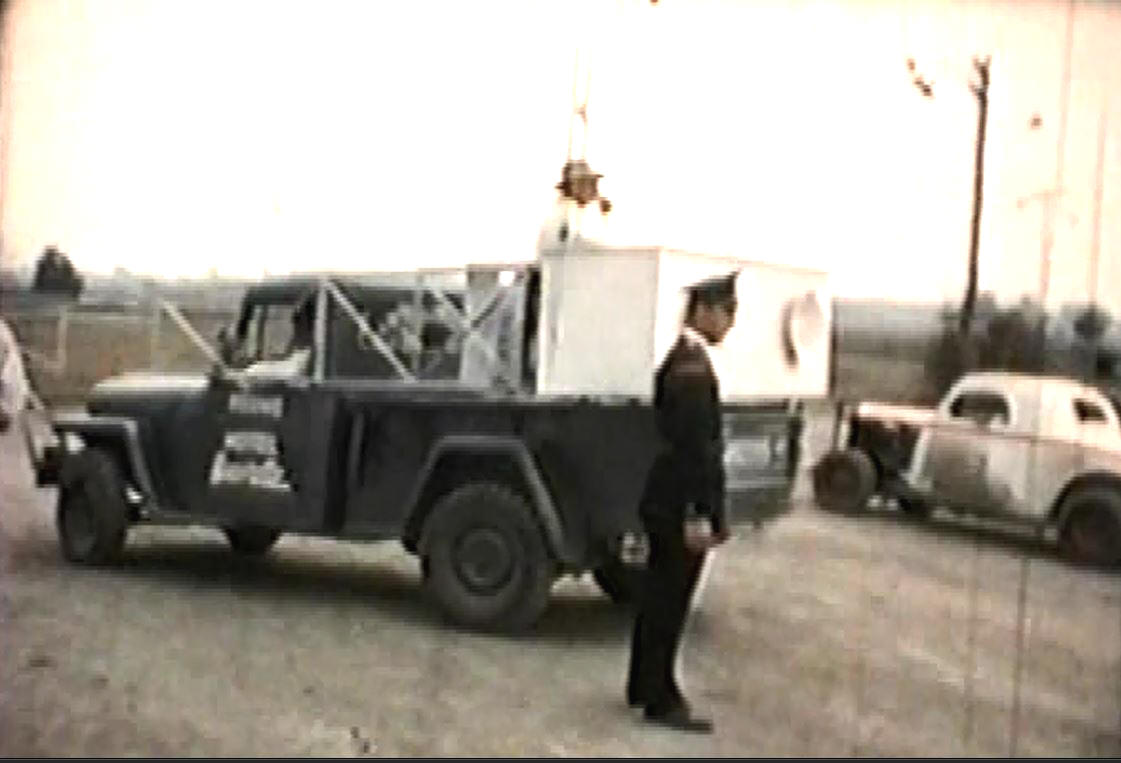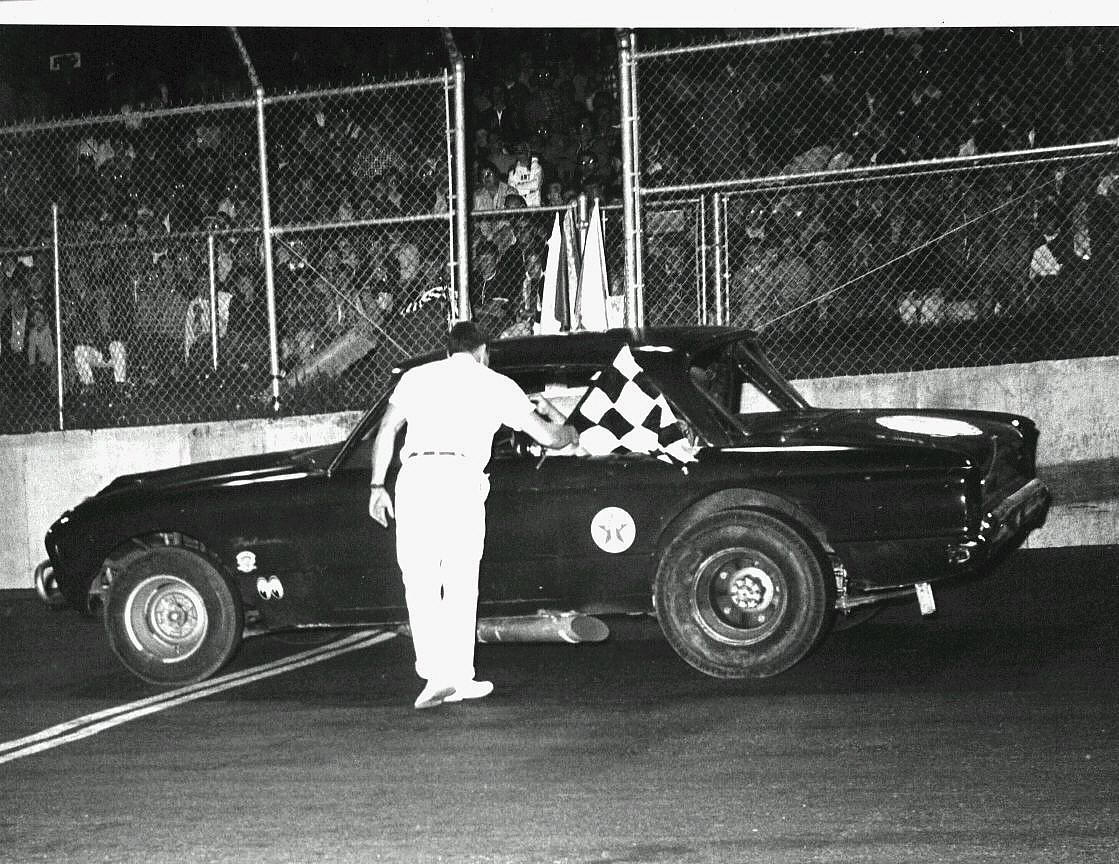Courtesy of Jerry King
Chet Hames watches as a Pico field rumbles off to form up for his green flag on the next time around.
He'd do it right between the rows. [Below] – Chet on his customary perch at Fonda.
BILL'S
[Somewhat] REGULAR COLUMN/BLOG PAGE
| I discovered I had two fairly similar blogs I had written within the the last year - both centered around flaggers. Rather than eliminating one or trying to combine them, I decided to put his one up now and the other up sometime in the future. |
BILL’S BACK IN TIME
By Bill Ladabouche
THOSE DARING YOUNG MEN AND THEIR CHECKERED FLAGS
The popular image of a race flagger among those not particularly familiar with auto racing is an almost formally dressed man with one of those Ivy League hats like golfer Payne Stewart used to wear, standing next to a track surface swooshing a checkered flag at a speeding open wheel car streaking safely by him. Yup, that might have been the case for a few years; but not with early stock car flag men.
When I was really little, and my family had taken me to a few shows at the short – lived Pico Raceway track near Rutland, Vermont, all I wanted to be was a flagger like Chet Hames, a man best known for his work at Fonda Speedway in the years immediately following his tenure at local tracks like mine. If I try hard, I can still vaguely recall the image of Hames dancing up and down amidst a field of stocks taking the green at Pico.
Courtesy
of Jerry King
Chet Hames watches as a
Pico field rumbles off to form up for his green flag on the next time around.
He'd do it right between the rows. [Below] – Chet on his customary perch at
Fonda.

Courtesy of Otto Graham
Hames was, at once, typical of early flag men and also atypical in the sense that only a few of these race starters had his kind of flair. Almost to a man, early flaggers started races down on the track with the cars, and then would proceed to regulate the rest of the race from beside the track. Hames a tall man who seemed to be composed almost entirely of legs, simply had more presence than most of his peers.
When the soon – to – be legendary Fonda Speedway opened at the Montgomery County fairgrounds in Fonda, NY in 1953, Hames would work in the dame manner until eventually, a concerned NASCAR issued guidelines for all of its flaggers that placed Hames up, off the track, [in his case] on a broad wooden stage of sorts right in front of the announcer's stand. Chet would still still strut and jump and keep the huge crowds entertained – although with some of the best sportsman racing taking place below him, he had to work hard to keep people's attention.
Bob Mackey Photo Courtesy of John Rock
Check out how close this 1955 field of cars is to Hames at Airborne Park Speedway. Future stars in this field include future national champs Dick Nephew and Bill Wimble, as well as the legendary Buck Holliday.In the golden years of the track, Fonda's announcer, Mike Valchovic, would always intone – at the beginning of the night's program – in his New York twang: “and your starter, the very popular, the very colorful Chet Hames....from Saratoga!” Chet was working Fonda, Victoria Speedway, and probably a few lesser venues like Whites Beach Speedway near Saratoga. It was stressful to be in danger that often. According to the Fonda history book, he was observed by Fonda promoter Ed Feuz depositing a six pack of beer at the infield concession stand. It had also been rumored he would stop for a few belts before arriving. Eventually Feuz removed the popular flagger, and Hames ended his career at tracks like Fairmont Speedway in Vermont.
Actually, Chet Hames likely woould have said he woed his start in flagging to a small, lesser - known track near his home of Saratovga Springs, NY. McGregor Speedway was created by a group of men from the Saratoga area in the nearby town of Wilton - perhaps as a protest to the way one ofthgeir own had been treated at another nearby track. Hames would take over flagging one afternoon when Frank Steiger, a memebr of one of the founding faqmilies, was struck by a car when flagging one of the qualifiers. Unaffected by it all, the tall Hames stepped in and never stopped flag wagging after that. There, he would also meet the man who became his protege.
Courtesy of Joe Staiger
Chet Hames [rt] stands with Frank Staiger just before the latter went oout, got his, and promptly quit flagging at McGregor Speedway around 1951.Behind them is Harold Kyer, a star stock car driver of that era.My first real good look at a flag man was Hames protege, Danny Rumpf, another Saratogian who had started out his racing life as a crewman for a few prominent area race drivers. When C.J. Richards re-opened the dormant Fairmont Speedway in 1962, his flagger was Rumpf. Danny, an incredibly thin man, dressed flamboyantly, with a black and white striped shirt and white pants with a stripe down the sides. He topped it all off with cowboy boots. The clothes hung on him.
Bob Frazier Photo Ladabouche Collection
Danny may have been the absolute boss, but he needed some smaller clothes on the job. Here he is with Art Cody, one of the dominant New Hampshire flathead runners. Below – Danny appears on the Otter Creek Speedway track with another NH driver, Ted Brown. It looks like he is making an adjustment for Ted.

Courtesy of the LaFond FamilyRumpf would also stand on the track, strutting and issuing orders to the oncoming field of cars with his flags. Announcer Bill Barsalow would explain, “Danny is the absolute boss out there – what he says goes.” Rumpf did not adopt his teacher's early penchant for starting a race from between the two rows of cars, but he did stay on the track apron in his first years of flagging. Miraculously, given some of the numchuks flying by him, he was never hit. Rumpf would work in another Saratoga resident, Jim Frye, into the craft, although the tough – as – nails Frye did not prefer to act flamboyantly when he ran the show later, at places like Devil's Bowl.
Not many years after the Hames departure, Don Phoenix, one of his successors, found himself flagging high above the track on a steel stand. Chet would have never wanted that because he would had to have stood still while flagging. He had a high stand at Fairmont, and chose not to do it for very long. When Chet left the scene, a big part of early stock car racing went out with him.
Phoenix Collection via Midstate Club
A young Don Phoenix awards checkers at the track in Morris, NY before he was hired on at Fonda. Below- Tex Enright in his prime.
Jeff Scott Photo via Ace LaneHames may have been the prime dancer on the track, with Rumpf not far behind; but, no one could match the outfit brought to the track by Tex Enright – who worked at places like Orange County Speedway in Middletown, NY. Reported to have Native American ancestry, Enright would arrive at the track in full western regalia, his long hair hanging out behind. Having once been a mechanic and [I think] a driver] Tex became the preeminent flagger in that high stakes New York/Pennsylvania/New Jersey dirt circuit that produced such greats as Will Cagle, Buzzie Reutimann, Wally Dallenbach, and Southern transplant Gary Balough. There may never be anyone who looked quite like Tex Enright on the flagstand.
Archie Blackadar is known to many Northeastern race fans as the Chief Pit Steward for NASCAR in the region, particularly in the 1970's; but, Archie started out as the flagger at Lower Waterford, Vermont's Northeastern Speedway in 1959. Quite flamboyant in his own right, Blackadar had been in on the group [most of whom all worked at the Ralston - Purina Plant in St. Johnsbury, VT] who had organized themselves into committees and developed the region's first organized race track.
Courtesy of Cho Lee
Archie surveys his realm from the flagstand at Thunder Road in 1960. Below- Archie
hands off the flag to Tony Collicchio in Andy Cote's 0 at Northeastern.
Courtesy of Ken PaulsenArchie also flagged at other NASCAR – sanctioned tracks such as Barre's Thunder Road and at the Colchester – Bayview Speedway in Malletts Bay, VT. The last flags Blackadar waved were seen at the first few shows at the Otter Creek Speedway in Waltham, VT, a NASCAR project that began in 1961. It is said that he started races on the track, ala Hames, and then leapt into a special ditch fashioned on the side of the racing surface as the cars careened off into turn one. Archie would have another full career as pit steward while wife, Dorothy Nichols Blackadar, did other officials' duties such as scorer and timer.
When young George Welch, of Schenectady, NY began showing up at Fonda in the early '50's, he had two idols – Steve Danish, the legendary race driver and Chet Hames. To emulate Danish, Welch became a good driver. Danish, one of the true pioneers in racing, always simply referred to his racing effort as “Danish Chevrolet”, and had this on the car and some T – shirts. Welch brought out a `1936 Chevy coupe and had “Welch Chevrolet” in the same places. He was a good driver, but that wasn't the problem.
Courtesy of Jo Towns via Otto Graham
Young George Welch even looks like Steve Danish here in this early Fonda photo.
Below - Link Pettit and Pinky the Clown join starter John Garvey in this early Pine Bowl photo.
ll
Courtesy of Link PettitHe also admired the strutting Hames, and he took up flagging at the paved Menands oval known as Empire Raceway. Welch must have been a mighty busy man because not only did he hold a job, but he was racing at least twice a week and flagging at Menands due to its unusual schedule night. Some time in the late 1950's, Welch was flagging off a race when he was struck by a car driven by one of the track's lesser – known drivers. He died in the hospital soon after. Fonda held a special race program, featuring teams from there, from Whites Beach, from Lebanon Valley and from Route 66 Speedway to raise money for the now – fatherless Welch kids. George's death brought about some changes in where flaggers were allowed to stand.
As was true with most aspects of stock car racing, things were seldom more extreme than they were in the Canadian province of Quebec. Flagging was no exception. It was not at all unusual to see a man clad in a Sunday church suit, standing before a motley group of stock cars. Some of these flaggers did not have a long life expectancy, and more than one prominent Canadian stock car veteran of the '50's has related tales of actually striking a flagger. They were not very careful in their quest to capture the attention of the crowd.
Courtesy of Michel Jacques via Pascal Cote
Clad in a white mechanic's coat over dress clothes, a starter at the Autodrome Ste-Monique in Quebec stands before a motley assemblage of true stock cars. Below – Paul Demers, arguably the best know Quebec flagger, stands in Victory Lane with driver Albert Angel and others.
Courtesy of Pascal Cote
A gentleman who worked on various track safety crews tells of one instance where a flag man gave a driver the black flag. The driver ignored the flagger until it became clear he could not continue. Incensed, the driver eluded efforts to corral him and mounted the dirt bank on which the terrified flagger was standing. The “conducteur” leapt to safety while the offending “Chauffeur” was tackled and removed.
Perhaps the strangest manner of directing racing came at St. Jerome, QC's Bouvrette Speedway, an elegant old horse track operated by Monsieur Gustave Bouvrette. Bouvrette would start the races with the gated Jeep he used to start the trotters on other days. The flagger was simply there to provide the rest of the signals for race, standing right on the side of a very dusty track. How he survived I will never know.

Courtesy of Andre Chausse
Gustave Bouvrette and his officials with the infamous starter Jeep.Quebec would eventually produce starters like Paul Demers, the dean of Quebec flaggers and Paul Boyer. The tracks eventually calmed down and installed some of the same safer stands as south of the border. One that I saw at the short – lived Mustang Speedway, a dirt track in Pike River, QC, was simply a metal stand above a set of stairs and the track signal lights [all one unit]. Racing, in general, was seldom dull in Quebec.
The art of flagging never was, and never will be particularly safe, but they did tame it down by the end of the sixties. Most tracks had to have flagstands, usually set back away from the racing surface. The next generation in my region included a number of men trained by the old school guys, but who could not do much of what their mentors had done. At Catamount and Thunder Road, starters like Bob Quinn, Jack Paradee, and Pat McGraff were now flipping the colors. Down south further, Devil's Bowl was using Frye, Bunny Bunnell and – yes – still Rumpf occasionally. Ted Ryan reigned at the Valley while other including Phoenix ran the show at Fonda.
Courtesy of Chris Companion
Clem Despault, with Catamount starter Jack Paradee. Below - Ted Wynot [left] and his Claremont predecessor, Ted Burr.
Photos Courtesy of Phil ChastenayClaremont Speedway had a well -thought – of flagger named Ted Wynot. Ted was around in the older days of the track, when it was basically a dirt oval cut out of a sandpit with some damned strange – looking cars. The name Claremont Jalopy Association gives you an idea of what it was like. However, to be fair, the track developed a core of strong – running pre-1936 flathead – powered coupes that would regularly invade Vermont and dominate action at Fairmont and Otter Creek ,as well as big races at the Vermont State Fair in Rutland. Winot oversaw that action until some time into the 1960's, when the track was paved and the divisions turned to the overhead V-8.
Mostly as a way to save the forsaken Ford flathead racing car, well – known Northeastern car owner George Barber, of Bradford, VT, open a very rustic fifth – mile track on a mountain top near his hometown as a place for all those dozens of old flatheads could still run among themselves. Wynot ended up there when it opened in 1968. Along with Emilio Girelli, a refugee from Thunder Road who had driven flatheads, Winot ran the quaint, but hugely – attended Bear Ridge Speedway programs until he retired. Even with the nostalgic, informal atmosphere at the Ridge, officials did not want to see Wynot flagging from the track -and he didn't.
Courtesy of Peter Falconi
Brookline Speedway starter Dave Faulkner with Pete Salvatore.
Over the years. much like Claremont, Bear Ridge went through phases that brought it into the more modern era; but Ted Winot got to enjoy it when it was still like the old days. Stock Car Racing magazine did a somewhat condescending article on the track in the early '70's; but , it gave the little – know oval some badly – needed publicity. Ted Winot may have been twirling the colors then.
Tracks did what they could to make flagging safer. Lancaster Speedway, an elaborate facility out near Buffalo, NY, had its flagger on a bridge – like structure over the paved racing surface. Wes “Slugger” Moody tells of the night he towed all the way out there to try his hand at qualifying for one of the big, season – ending races like Syracuse or Nazareth.
“Everyone was there, and they all wanted the same thing I did”,relates Moody. “My qualifier was loaded and me and Merv Treichler were apparently eying the same spot to grab on the start”.
In the support division heats earlier, a late model driver had already struck that starter structure [apparently something that never happened] and had left the poor starter, Bruce Fleischman, clinging for dear life above the track while workers figured out how to get him and the assistant starter down. To make a long story short, Moody and Treichler both leapt to the task, arriving at the same spot at the same time. The brand new Moody car went airborne, through what was left of the structure, over the fence, and into a special ramp apparatus that was to be used in a stunt during the evening.
The carnage following the Terry Goerss and Wes Moody wrecks at Lancaster. Crews try to salvage something of the flagger's stand.
From the Lancaster History Book
It is not clear if they ever got that poor starter to resume his duties. Moody, who was admonished by the prominent auto engineer who had designed the ramp, was encouraged not to return to Lancaster. His newly – built modified coupe was going home in a basket.
The life of a flagger became a lot less exotic, albeit still not terribly safe. While starters at Thunder Road still stand out in the open on the bank above the frontstretch wall, their counterparts at Catamount Stadium flagged while peeking out through an opening in the catch fence. I recall a time when Bob Quinn and whoever his assistant was at the time had to duck an errant car battery which passed over, spraying them with acid as it went. They shook it off.

Dragon Family Photo
Bob Quinn hands off the checkers to Beaver Dragon at Catamount. Note the little niche in fence made for the flagger. Below- Archie Blackadar starts an early Thunder Road field precariously between the oncoming rows. See the assistant starter on the virtually unprotected flagstand in the background.
Courtesy of Cho LeeToday, at Devil's Bowl for example, starter Bob Bigelow stands above the track, behind a fence, wearing a helmet just like the ones the drivers have. He still is not safe. Anything could fly off cars going over 100 M.P.H. As they pass under him. The Airborne flagger is also situated above the track on a stand. In 1984, flagger and former driver Don Thomas was knocked completely off the stand by a careening, barrel – rolling Ed Champagne. Thomas was scraped off the clay and brought to medical center under protest. He showed up at the weekly post – race beer bash at Al's Patchwork bar later that night. Tough guys over there.
Plattsburgh Press Republican via Bobby Castine
This newspaper clipping shows the aftermath and chaos of the Champagne/flagstand wreck.
Yes, flagging lacks much of the flair and mystique of the early days of stock car racing; but Ye Gods ! Who would want to start today's races standing on the track between the cars ??!!
Please email me if you have any photos to lend me or information and corrections I could benefit from. Please do not submit anything you are not willing to allow me to use on my website - and thanks. Email is: wladabou@comcast.net . For those who still don’t like computers - my regular address is: Bill Ladabouche, 23 York Street, Swanton, Vermont 05488.
AS ALWAYS, DON’T FORGET TO CHECK OUT THE
REST OF MY WEBSITE
www.catamountstadium.com
Return to the Main Page
Return to the Main News Page
Return to the All Links Page
Return to the Weekly Blog Links Page